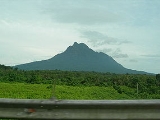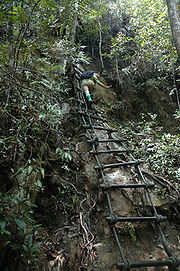
Mount Santubong
Encyclopedia
Mount Santubong is a mountain
in the Malaysian state of Sarawak
. It is located about 35 km north of the state capital Kuching
.
On a clear day, it can be seen from Kuching. The mountain and its surrounding area is a popular tourist attraction.

. Si-antu-ubong means 'spirit boat' in the Iban language. Antu is hantu in Malay which means spirit or ghost. Santubong are boat like coffins made from a single hollow log designed to represent the vesell in which a dead person will travel from this world to afterlife.
Following another theory, the name Santubong is derived from "san choo bong" in the Hakka Chinese
dialect
, meaning "wild pig king" or "king of wild pig".
and Buddhist
relics from the 9th Century CE
. Song
and Tang dynasty
ceramics are also found, indicating that the area around the mountain was a trading port from the 11th to 13th century.
http://etext.library.adelaide.edu.au/w/wallace/alfred_russel/malay/ who was collecting animals in Santubong, wrote a paper called "Sarawak Law" http://www.wku.edu/~smithch/wallace/S020.htm which can be considered as a precursor to the biological theory of evolution. A year later, Wallace left Sarawak and wrote another article on evolution based on his years of observation in the Far East, that was sent to Charles Darwin
and was simultaneously published by the Royal Society. Similar to Galapagos, Mount Santubong should be considered as a scientific world heritage in biological science and should be preserved for the future genarations. Unfortunately, the proposal to established the area as a national park never materialise and human settlements as well as touristic development (hotels, golf course and condominium) are claiming most of the low lying areas. It is suggested the world community to set up a fund to buy back the land and save Mount Santubong that is very important in the development of concepts and theories in biological sciences.
Villagers say the well at the top never dries up, however this pond is often sadly full of rubbish today and should not be relied upon as a source for thirsty climbers. In fact Lord Medway reported it to be dry on his overnight expedition to the top in the 60's before the ropes and ladders were installed. Cub scouts and guides once camped at the top too on their expeditions.

Mountain
Image:Himalaya_annotated.jpg|thumb|right|The Himalayan mountain range with Mount Everestrect 58 14 160 49 Chomo Lonzorect 200 28 335 52 Makalurect 378 24 566 45 Mount Everestrect 188 581 920 656 Tibetan Plateaurect 250 406 340 427 Rong River...
in the Malaysian state of Sarawak
Sarawak
Sarawak is one of two Malaysian states on the island of Borneo. Known as Bumi Kenyalang , Sarawak is situated on the north-west of the island. It is the largest state in Malaysia followed by Sabah, the second largest state located to the North- East.The administrative capital is Kuching, which...
. It is located about 35 km north of the state capital Kuching
Kuching
Kuching , officially the City of Kuching, and formerly the City of Sarawak, is the capital and most populous city of the East Malaysian state of Sarawak. It is the largest city on the island of Borneo, and the fourth largest city in Malaysia....
.
On a clear day, it can be seen from Kuching. The mountain and its surrounding area is a popular tourist attraction.

Etymology
According to the Encyclopaedia of Iban Studies the original inhabitants of Santubong were the IbanIban people
The Ibans are a branch of the Dayak peoples of Borneo. In Malaysia, most Ibans are located in Sarawak, a small portion in Sabah and some in west Malaysia. They were formerly known during the colonial period by the British as Sea Dayaks. Ibans were renowned for practising headhunting and...
. Si-antu-ubong means 'spirit boat' in the Iban language. Antu is hantu in Malay which means spirit or ghost. Santubong are boat like coffins made from a single hollow log designed to represent the vesell in which a dead person will travel from this world to afterlife.
Following another theory, the name Santubong is derived from "san choo bong" in the Hakka Chinese
Chinese language
The Chinese language is a language or language family consisting of varieties which are mutually intelligible to varying degrees. Originally the indigenous languages spoken by the Han Chinese in China, it forms one of the branches of Sino-Tibetan family of languages...
dialect
Dialect
The term dialect is used in two distinct ways, even by linguists. One usage refers to a variety of a language that is a characteristic of a particular group of the language's speakers. The term is applied most often to regional speech patterns, but a dialect may also be defined by other factors,...
, meaning "wild pig king" or "king of wild pig".
History
Excavations of the surrounding area uncovered HinduHindu
Hindu refers to an identity associated with the philosophical, religious and cultural systems that are indigenous to the Indian subcontinent. As used in the Constitution of India, the word "Hindu" is also attributed to all persons professing any Indian religion...
and Buddhist
Buddhism
Buddhism is a religion and philosophy encompassing a variety of traditions, beliefs and practices, largely based on teachings attributed to Siddhartha Gautama, commonly known as the Buddha . The Buddha lived and taught in the northeastern Indian subcontinent some time between the 6th and 4th...
relics from the 9th Century CE
Common Era
Common Era ,abbreviated as CE, is an alternative designation for the calendar era originally introduced by Dionysius Exiguus in the 6th century, traditionally identified with Anno Domini .Dates before the year 1 CE are indicated by the usage of BCE, short for Before the Common Era Common Era...
. Song
Song Dynasty
The Song Dynasty was a ruling dynasty in China between 960 and 1279; it succeeded the Five Dynasties and Ten Kingdoms Period, and was followed by the Yuan Dynasty. It was the first government in world history to issue banknotes or paper money, and the first Chinese government to establish a...
and Tang dynasty
Tang Dynasty
The Tang Dynasty was an imperial dynasty of China preceded by the Sui Dynasty and followed by the Five Dynasties and Ten Kingdoms Period. It was founded by the Li family, who seized power during the decline and collapse of the Sui Empire...
ceramics are also found, indicating that the area around the mountain was a trading port from the 11th to 13th century.
Legend
A legend often associated with the mountain is of two beautiful princesses, Santubong and Sejinjang. Santubong was an expert weaver while Sejinjang was an excellent rice tresher. One day, they had a quarrel and exchanged blows. Sejinjang swung her tresher which hit Santubong's cheek. Santubong threw her weaver at Sejinjang, hitting her in the head. Putting an end to the quarrel, the King of Heaven cursed both of them into mountains. Santubong turned into Mount Santubong while Sejinjang was turned into Mount Sejinjang. It is said that Mount Santubong resembles a woman lying on her back.Importance to Biological Science
In 1855 a British naturalist, Alfred Russel WallaceAlfred Russel Wallace
Alfred Russel Wallace, OM, FRS was a British naturalist, explorer, geographer, anthropologist and biologist...
http://etext.library.adelaide.edu.au/w/wallace/alfred_russel/malay/ who was collecting animals in Santubong, wrote a paper called "Sarawak Law" http://www.wku.edu/~smithch/wallace/S020.htm which can be considered as a precursor to the biological theory of evolution. A year later, Wallace left Sarawak and wrote another article on evolution based on his years of observation in the Far East, that was sent to Charles Darwin
Charles Darwin
Charles Robert Darwin FRS was an English naturalist. He established that all species of life have descended over time from common ancestry, and proposed the scientific theory that this branching pattern of evolution resulted from a process that he called natural selection.He published his theory...
and was simultaneously published by the Royal Society. Similar to Galapagos, Mount Santubong should be considered as a scientific world heritage in biological science and should be preserved for the future genarations. Unfortunately, the proposal to established the area as a national park never materialise and human settlements as well as touristic development (hotels, golf course and condominium) are claiming most of the low lying areas. It is suggested the world community to set up a fund to buy back the land and save Mount Santubong that is very important in the development of concepts and theories in biological sciences.
The Ascent
It takes between 3 and 4 hours to reach the summit and slightly less to descend again. Climbers need to take plenty to drink and some food to keep them going. A BBQ has been built at the top but begin your descent by 3pm to get back in the day light and avoid stepping on snakes that cross the path sometimes. A lucky climber may be rewarded with the chance of a rare Hornbill with a cream/yellow beak. These Hornbills are black and white.Villagers say the well at the top never dries up, however this pond is often sadly full of rubbish today and should not be relied upon as a source for thirsty climbers. In fact Lord Medway reported it to be dry on his overnight expedition to the top in the 60's before the ropes and ladders were installed. Cub scouts and guides once camped at the top too on their expeditions.


